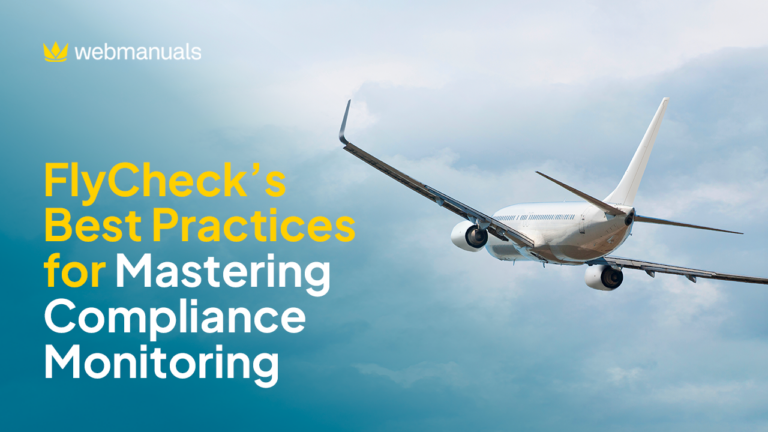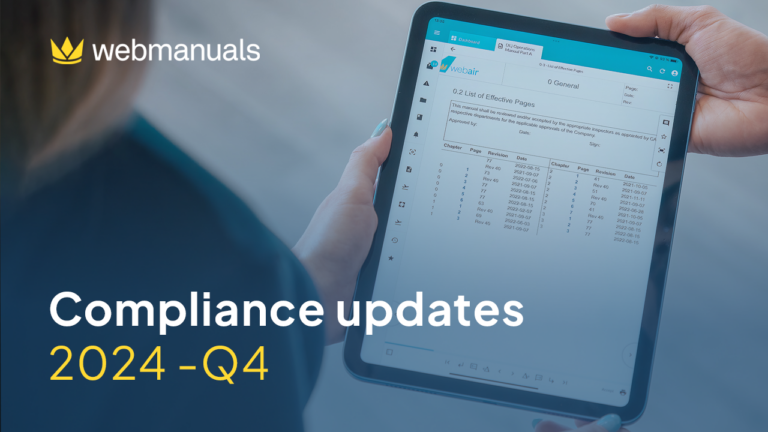Published by: Aircraft IT
In this article, Pattaraporn Jantarasamee will address the K-Mile experience of implementing a digital document management system while Emil Ahlgren will cover the processes and technology of digital documentation.
While this case study is primarily about the introduction of a modern digital documentation system into K-Mile Air, in order that readers will understand the context, we’ll start with a brief introduction to the airline.
K-Mile Air
As the first Thai registered express freighter airline, K-Line operates out of Bangkok Suvarnabhumi Airport. The fleet comprises Boeing 737 400 and 737-800 aircraft serving major cities across South East Asia including Hong Kong, Jakarta and Singapore.

So, you might ask, why did K-Mile decide to go for a digital documentation transformation?
The reasons for going digital
There were three key drivers that moved K-Mile toward this digital transformation. The first driver, to which all readers will relate, was safety and compliance, non-negotiable in the airline industry. Even though K-Mile, as a cargo airline, does not carry passengers, its mission is to ensure the safety of crews and shipments. The second driver was to increase the efficiency of K-Mile’s document management system. Third, we wanted to reduce the valuable man hours spent on document editing. We also realized that the previous system used by K-Mile was no longer sustainable and could not keep up with the ever-changing aviation landscape.
So, lets wind back to the situation prior to the implementation of Web Manuals. Initially, K-Mile relied heavily on traditional word processing software which was used to manually craft documents before converting them into static PDF files which were then electronically distributed to all manual holders through the existing safety and quality management system. However, we were faced with multiple challenges to which readers using PDF files and PDF document distribution will be able to relate.
The first problem was inter-document and regulation referencing. When one item in one document was revised, it was necessary to go back to review all the other documents that included that item and/or referenced the document in question, then revise them, if necessary. It was becoming an increasingly difficult process to keep up with evolving requirements and regulations. Secondly, formatting inconsistencies with bullet numberings, font size, capitalization… had become a constant headache and led to a lot of presentation issues. Version control was the third problem. On several occasions, it was discovered that users had downloaded PDF documents onto their personal devices but failed to update when a new revision of those documents became available. That resulted in the use of out-of-date documents which was not good from a compliance point-of-view. Next, the system that we had been using previously lacked the ability to track the document review and approval path, which meant that it had to be done manually outside of the system. Finally, there were security concerns where we questioned unauthorized alterations and revisions to the PDF document, and that also negatively impacted compliance.

These challenges were the airline’s daily reality and were substantial. It had become clear that we needed some sort of transformation and solution. The primary objective was to address the pain points listed above and transition to a more efficient, secure and compliant document management system (figure 2 above).
Finding the right solution for K-Mile
At the start, we proposed the implementation plan to top management to make the change-over using the mechanism of MoC (Management of Change) under the airline’s safety management system. This formal MoC approach not only helped us to identify potential hazards associated with this change but it also ensured that all tasks were effectively prioritized and monitored.

We also worked closely with the Web Manuals team to create a realistic timeline. Web Manuals’ extensive experience working with other airlines and aviation entities proved invaluable to the project. Most importantly, K-Mile decided to adopt a balanced approach to make sure that no-one, from admin users, reviewers and editors to readers, felt overwhelmed by the change. User experience and facilitation were at the forefront of our strategy. We recognized that embracing such a substantial change could be daunting for our teams. So, to ensure a smooth transition, we made thoughtful choices.
Moreover, we prioritized communication. Open and transparent dialogue was essential to assure our teams that they were an important part of this transformation journey. We even went the extra mile by adding Thai subtitles to the user self-study videos, ensuring that language barriers didn’t hinder comprehension. Our goal was not just change, but change that would enhance our operations while making it as seamless as possible for our teams. We also worked closely with the Web Manuals Team to create a realistic timeline, ensuring every aspect of the transition was meticulously planned. In the end, the project was completed in six to seven months. Web Manuals’ extensive experience from working with various airlines and aviation entities on similar projects proved invaluable. We divided the implementation plan into two phases to prevent overload and to facilitate user adaptation.
Phase 1
The primary objective was on project communication. Department heads, document editors and users, and even the local regulatory authority were engaged into the process to secure their buy-in, creating a shared vision of the transformation. The involvement of the local authority not only demonstrated our commitment to compliance but also helped foster trust. The project team reached out to all users, editors and reviewers, plus including external service providers for whom the airline intended to give access to the new document management system. Training was divided into two parts.
Editor training was provided by the Web manuals team providing hands-on, virtual training sessions (it was during the Covid time), and with the main focus on system interface, document development and editing. That was followed by reviewer and reader training which was mainly done using self-study materials that were available in the system itself. As all the self-learning materials at that time were in English, it was decided to add Thai subtitles to make sure that language would not be a concern for users. We even established a dedicated help desk to support all users who could contact the desk throughout the transition period via emails, group chat or a phone call.
Most importantly in Phase 1, all K-Mile’s existing PDF documents were transferred from the previous system into the new system. Initially, all of these documents retained their original PDF format. This was done on purpose to ensure that, first, all the users could focus on familiarizing themselves with the new system’s look and feel, and interface.
With phase 1 providing a solid foundation, the project moved on to phase 2 which was dubbed ‘the heart’ of the transformation.
Phase 2
In phase 2, all of K-Mile’s major manuals, including OM-A and GMM were fully transformed into web-based documents in the new system. The transfer process started with the major manuals because they are frequently and heavily referred to by other manuals. That was followed by less frequently referred to manuals such as OM-B, OM-C and Maintenance Program Data. Editor coaching continued with editors’ user support by both the document controller and the Web Manuals team. There were also extensive communications continuing.
As at the time of writing, all of K-Mile’s documents, except for manufacturers’ manuals, were in a fully web-based format and we were confident to be able to say that the users had embraced this technological change with remarkable ease.
Benefits and outcomes
As a result of the implementation, K-Mile’s operational efficiency soared, errors significantly decreased and valuable man-hours were saved.

More importantly, the airline’s compliance standards have improved as has the trust from K-Mile’s local regulatory authority. A few months after the implementation of the new system, K-Mile was audited by the local authority and the number of non-compliances had significantly reduced. The same audit was also conducted the following year and the airline emerged with zero non-compliance, a huge benefit from the transformation.
However, that doesn’t mean that the journey was without any challenges and we certainly learned some lessons.
Lessons learned
Here are the lessons that K-Mile learned along the way and we hope you’ll find them useful should you decide to implement such a transformation.

The first thing learned was that people adapt to change differently and not everyone finds it easy to embrace this new technology. Bearing that in mind, we organized some customized training during the process with coaching and moral support; explaining the ‘why’ behind this transformation. The airline relied heavily on department heads to address any user resistance.
Second, the editors encountered minor technical and content issues but these issues were promptly resolved by the Web Manuals team with any unresolved issue either being put in a backlog or a suitable work-around being found.
Lastly, it became clear that content creation needed more time than we had anticipated because, during the transition from the PDF documents to the web-based documents, the editors had not only to transfer the file format but they had to review and make sure that linked and reference content was also accurate. It was a very time consuming task.
We also found that, while the implementation project had been planned based on some ideal assumptions, it had failed to take into account unforeseen circumstances such as operational disruptions and other ongoing projects so the first revisions of the fully digitalized documents were accepted based on the acknowledgement that they may not have perfectly complete references. Notwithstanding that, it was an excellent start for K-Mile.
Sustainability and long-term strategy
The journey is far from over and, for sustainability and long-term strategies the airline realizes that a robust document management system will serve as a good foundation for operational safety.

So, K-Mile will continue reviewing and refining all of our documents to achieve a level as close to perfection as possible. The aim will be to do this through a formal auditing process with a more informal feedback process to encourage all users to contribute their experience, ideas and change requests to document editors through the existing system functions to make sure that editors receive as much feedback as possible regarding accuracy and inconsistencies.
Compliance to regulations is very important. Regulations are regularly changing and updating, and our local authority is implementing the performance-based regulatory framework similar to EASA’s. During this transition we are pretty confident that our transition will be smoother. We’d also like to incorporate other regulations, including the regulations from foreign regulatory authorities, into our system and documents as well.
With scalability and system integration, we are aiming to integrate our new document management system into other areas such as the auditing system, emergency response plans as well as the Electronic Flight Bag (EFB). We will also continue user training and communication to make sure that they fully utilize the system functionality as well as to empower them with the tool that we all need for the success of our document management system.
As a next step on the compliance part, the TCARs (Thailand Civil Aviation Regulations) are being implemented and Web Manuals is also implementing the TCAR into its software with K-Mile set to be one of the first operators in Thailand to become TCAR certified. That will be the next part of our journey together.
What is digital documentation?
Just to conclude the article, we often get asked to define digital documentation so here is a brief explanation. At first sight, digital documents, maybe html documents, and PDF documents might look the same but, in reality, they can be very different. We hear so many different versions of what is a digital document as well as a digital document management system, and there are so many misconceptions. Just because a document is created using word processing software, converted into a PDF and then put in a shared folder does not make that document digital, even though a lot of people think it does. A digital document, or an html document in this case, can include a lot of background data whereas a PDF is more of a static document with less data in the background.
Just generating a PDF document and making it available is really a one-way communication reliant on someone fetching that document or perhaps it can be pushed out; hence, a one-way communication. One thing that we hear very commonly is losing control with locally stored copies, documents out there but waiting for someone to download them. That makes it hard to be sure what is the latest version of the document or who has it; and to interact with it in a two-way process is almost impossible.
A topic that has been talked about very much lately is ‘a single source of truth’ but it’s very hard to ensure that there is a single source of truth without having the information centralized and in control.




